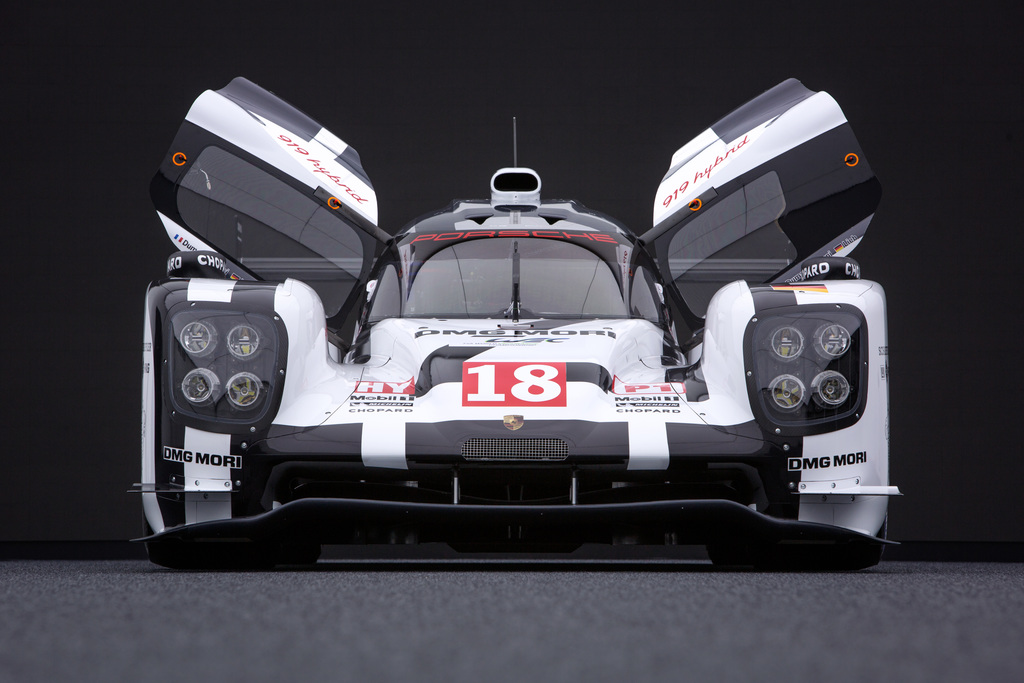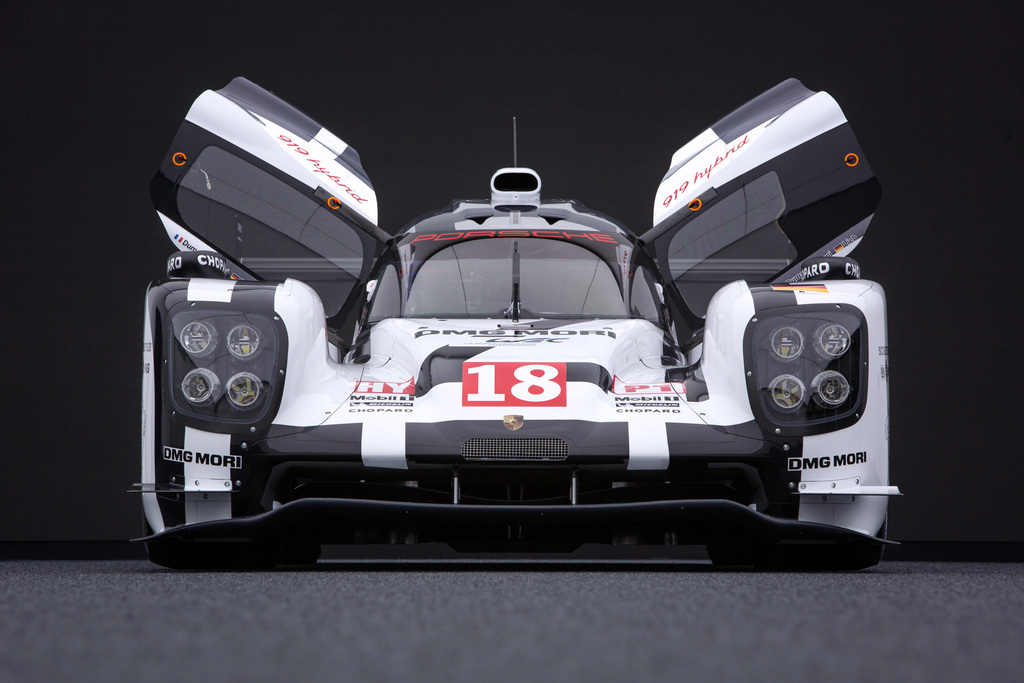2015 Porsche 919 Hybrid
The 2015 season Porsche released a new version of their 919 LMP1 prototype which was reshaped and significantly upgraded to the Premiere class which uses an 8 megajoule hybrid electric system. It follows the 2014 car which had competitive but lackluster year against Audi and Toyota.
Combined with a 2 litre, twin turbo V4 gasoline engine is the 8 megajoule lithium-ion battery which powers the front electric engine for a total power output nearing 900 to 1000 bhp. The system uses energy recovery on the front electric engine and also with the turbocharger system.
Press Release
Porsche is returning to the top category of the famous endurance race classic at Le Mans and the World Endurance Championships (WEC) for sports cars with its newly developed 919 Hybrid. The LMP1 prototype, which is designed for extreme efficiency, is the most complex race car that Porsche ever put on wheels.
It serves as a research platform for fundamental technology to be used in future production models, with its combination of two different energy recovery systems and a downsizing turbocharged engine. So the real winner of Porsche factory racing is already clear: it is the customer.
The World Endurance Championship (WEC) for sports cars launches into a new era, beginning on 20 April at Silverstone in Great Britain. The season highlight, Le Mans, follows in June. The newly formulated regulations for the top class of this World Championship has completely changed in focus. From now on, the sporty performance of the LMP1-H prototypes will be rated in direct relationship to their energy efficiency. While the allowable fuel quantity per lap was reduced by around 30 per cent compared to the prior year, the amount of energy of the obligatory hybrid systems that can be used in the race was dramatically increased. This shifts technologies into the limelight that are most significant for future production vehicles. From the perspective of Porsche, that is a decisive argument for a return to the top league of sports car racing.
Maximum efficiency of all elements as development goal
Porsche engineers are taking on the challenges of the WEC regulations with innovative solutions and all the creativity they can muster. The development of the Porsche 919 Hybrid began in mid-2011 – literally on a blank sheet of paper. As newcomers, the developers had to do without the greater experience that their competitors in the LMP1 category enjoyed. However, they were able to access the know-how that Porsche had acquired in its racing success with the 911 GT3 R Hybrid and the 918 Spyder super sports car, which is also hybrid-driven.
The exceptional efficiency of the highly complex technology of the Porsche 919 Hybrid is the result of a carefully balanced overall concept. From the combustion engine to the energy recovery systems, chassis and running gear, aerodynamics and driver ergonomics, the sum of all individual components forms an exceptionally effective unit. It all serves one goal: a maximum of sporty performance within tight fuel economy constraints.
In choosing a hybridised drive concept, the newly formulated WEC regulations gave Porsche developers great freedom. The drive system of the new LMP1 race car is based on a four-cylinder petrol engine that is as compact as it is lightweight. It performs load-bearing functions within the chassis based on its V-construction, which also offers thermodynamic advantages. The petrol engine, which reaches a maximum engine speed of around 9,000 rpm, is a frontrunner in terms of its downsizing philosophy with its 2.0 litres of displacement, direct injection and monoturbo charging.
It also features two different energy recovery systems. Fundamentally new and especially innovative is the recovery of thermal energy from exhaust gases. An electric generator is used here, which is powered by the exhaust gas stream. The functionality of the second hybrid system is known from the Porsche 918 Spyder. Here, a generator on the front axle utilises braking phases to convert kinetic energy into electric energy. It is also stored in highly-advanced water-cooled lithium-ion battery packs until the driver needs the extra energy. Then the front generator is operated as a single electric motor and drives the two front wheels via a differential in the acceleration phases. This gives the Porsche 919 Hybrid a temporary all-wheel drive system, because the petrol engine directs its power to the rear wheels in a conventional way.
Powerful hybrid drive for the 8 megajoule premiere class
Intelligent management of this additional available energy assumes a special role here. Of course, the strategic focus of the racing engineers is always on the most efficient use of available power. This means an optimal lap time. The driver can choose from several automated drive modes that have an effect on vehicle dynamics as a function of the traffic situation, course layout and weather conditions. At this point, the developers made use of knowledge gained by Porsche with the 911 GT3 R Hybrid, including at the 24-hour race on the Nürburgring.
The allowable petrol fuel consumption depends directly on the amount of electrical energy that the driver can call up per lap in what is known as the Boost function. Race rules distinguish between four levels ranging from 2 to 8 megajoules (MJ). Porsche is developing the 919 Hybrid for the “Premiere class” with an energy recover capacity of 8 MJ. This requires the use of high-performance energy recover and storage systems, which need to be sized larger and heavier. A flow meter device also limits the amount of fuel flow. Example of Le Mans: Here, the turbocharged petrol engine, which is driven at full load for 75 per cent of the 13.65 kilometre lap, only has 4.64 litres of fuel available. In the 2-MJ class, the figure is 5.04 litres.
In Detail
| type | Racing Car |
| built at | Germany |
| predeccesor | 2014 Porsche 919 Hybrid |
| engine | V4 |
| position | Front, Longitudinal |
| aspiration | Turbocharged |
| valvetrain | DOHC, 4 Valves per Cyl |
| displacement | 2000 cc / 122.05 in³ |
| power | 372.9 kw / 500 bhp |
| specific output | 250.0 bhp per litre |
| bhp/weight | 574.71 bhp per tonne |
| body / frame | Carbon-Fibre and Kevlar Body over Carbon-fibre Composite and Aluminium Honeycomb Monocoque |
| driven wheels | AWD |
| front tires | Michelin 310/710 – 18 |
| rear tires | Michelin 310/710 – 18 |
| front brakes | Brembo Discs |
| rear brakes | Brembo Discs |
| f suspension | Double Wishbones |
| r suspension | Double Wishbones |
| curb weight | 870 kg / 1918 lbs |
| length | 4650 mm / 183.1 in |
| width | 1900 mm / 74.8 in |
| height | 1050 mm / 41.3 in |
| transmission | 7-Speed Sequential |
| fuel capacity | 68 litres or 17.95 gal. |














